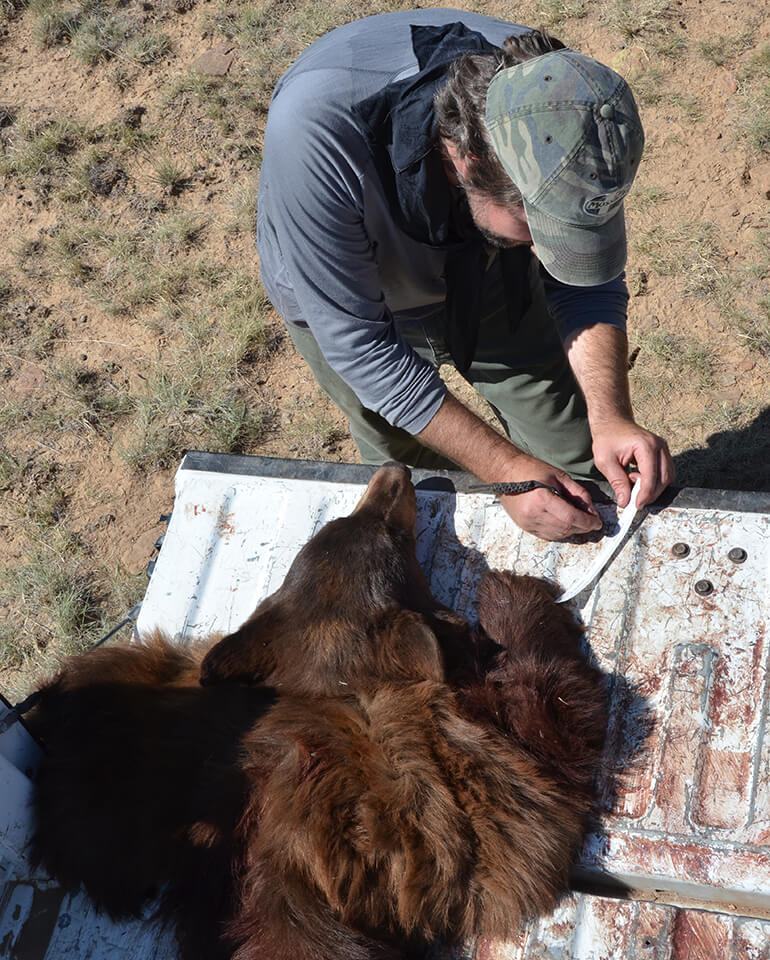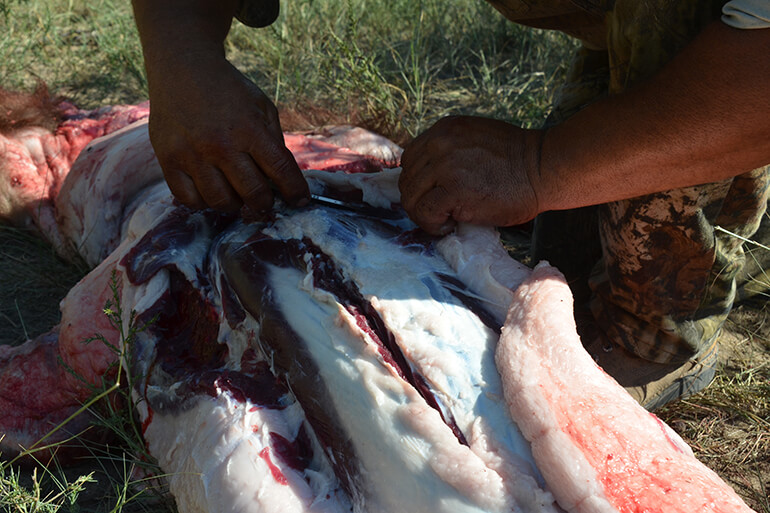
Print Recipe
When it comes to eating, bear meat gets a bad wrap in hunting circles. But it shouldn’t. Bruins aren’t as tough eating as they look. Taking bears that have been feeding on the right kind of diet can fill your freezer with meat that can have an underlying sweetness – as if caught with their paw in the honey jar. Here’s why you need to try black bear meat now and discover what you’ve been missing.
The best bear I ever ate ambled out of a New Mexican oak mott, as if it were more curious about my squealing predator call than actually interested in eating. Pulling back its tawny, blonde-tipped fur revealed a layer of exquisite fat, the consistency of jelly and white like a piano’s ivory keys. No animal with backfat like that could taste bad, and the meat from this bear was amazing – a sweet, yes, almost nutty, flavor that lent itself well to a whole host of recipes, from simple grilled steaks to slow braises that really pulled out the taste of the acorns it had been feeding on.
The second-best bear I ever ate dropped at the shot, nose first into the high-tide line of kelp and seaweed it was feasting on along Alaska’s southwestern coast. It was mid-May, and considering the bear’s last meal, its meat could have been nasty. Instead, the spring bear tasted as briny as the Bering Sea, almost like a good oyster pulled fresh from cold water. Each bite reminded me of the waves crashing along the rocky beach as my hunting partner and I pulled the heavy beast to the waiting Zodiac.

As you may have deduced from these two examples, the quality of bear meat is the direct product of the animal’s diet, even more so than a corn-fed whitetail or sage-eating antelope. While I personally have never eaten a bad black bear, the records are ripe with gut-churning reports of the salmon-eating bears of fall and their horrible fish-tainted taste. And lest you think that may be based solely on the tales of housewives, consider the state of Alaska which requires the salvage of all edible meat from black bears only during the spring season.
Still, when hunting bears – and we’re talking exclusively black bears here – it pays to consider their diet more than the calendar. That blonde-tipped bear from the Land of Enchantment that ranks above the half-dozen or so bears I’ve tagged and eaten was killed and cut in September. High-country bears shot in the fall are ripe with the flavor of wild mountain berries, and low-country spring bruins are often grassy and, yes, even grain fed, particularly those from the prairie provinces of Canada. Perhaps only dumpster bears, scavenging on the soiled scraps of the crap we humans eat should be avoided.
Of all the different variations bear meat can possess, there is a singular theme accenting all those wide and varied flavors, and that is the meat’s sweetness. Not cloyingly so, like a flower’s perfume, but just an underlying layer as if infused with just a hint of sugar or, to be cliché, honey. The flavor is there on the tip of the tongue, or the back, rather, a pleasant surprise in the otherwise meaty bite of every black bear.
The other universal truth about bear meat is its consistency. While an animal exhibiting that kind of power could be expected to have a tough chew, even the biggest bruins are typically tender. That Alaskan bear, a heavy boar measuring more than six feet from nose to tail, had roasts that were practically soft, with lengthy muscles fibers that lent themselves well to a long braise in a low oven. It’s true the surface fat found on bears is exceptionally slippery, but the meat itself is no more greasy than a well-tended pig.
When hunters describe bear meat to the uninitiated, they most often compare it to pork. It’s a misguided notion, however, one that likely comes from the physical resemblance and foraging habits of both quadrupeds. Once the skin is flayed, the idea that pork and bear meat is similar falls away. Though not deep red like the meat of deer, elk, or even cattle, it’s much darker than “the other white meat.” The flavor, too, is also far from that likely second-hand comparison to pigs.

There is one similarity between hogs and bruins, and it’s worth noting anytime the discussion turns to eating bears. Both animals can be host to a virulent parasitic worm Trichina spiralis, best known as trichinosis. While the parasite has all but disappeared from domestic pork, it’s all too common among bears. In fact, of all the cases of trichinosis in humans each year, most, if not all, can be traced to eating bear meat. Luckily, trichinosis is easy to beat: simply requiring the meat reach an internal temperature of 140 degrees and held there for several minutes. That means no medium-rare bear steaks, but anything cooked above that temperature will be just fine.
Although the pendulum is swinging back, game meat gets a bad rap in many social circles, including those inhabited by hunters. And bear meat probably gets the worst, as information, mostly wrong, gets spread second- and third hand by hunters who have never tasted bear meat, let alone cooked it themselves. Those in the know, however, rate the meat of a black bear shot off a berry patch, or in my case, a pile of nuts, among the best.
Bear Sauerbraten Recipe

Here, a bear roast gets the traditional sauerbraten treatment with a long marinade in red wine and vinegar, with a slightly sugary sauce that pairs with the natural sweetness of the meat.
Serves: 4Prep time: 30 minutes + marinade timeCook time: 3 hours
Ingredients:
- 1 (4-pound) bear roast
- 1 ½ cup red wine
- 1 cup red wine vinegar
- 2 onions (1 grated, 1 chopped)
- 1 carrot, chopped
- 1 celery stalk, chopped
- 6 juniper berries
- 4 bay leaves
- 4 cloves
- 1 tablespoon black peppercorns
- Kosher salt
- 3 tablespoons bacon fat
- 2 tablespoons butter
- 2 tablespoons flour
- 1 tablespoon sugar
- ¼ cup golden raisins
- ¼ cup chopped parsley
Get the Recipe: Bear Sauerbraten









































![Air gun 101: The differences between .177 & .22 – Which jobs they do best ? [Infographic]](https://airgunmaniac.com/wp-content/uploads/2020/09/g44-150x150.jpg)

